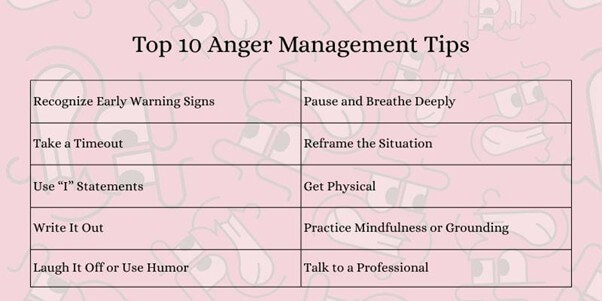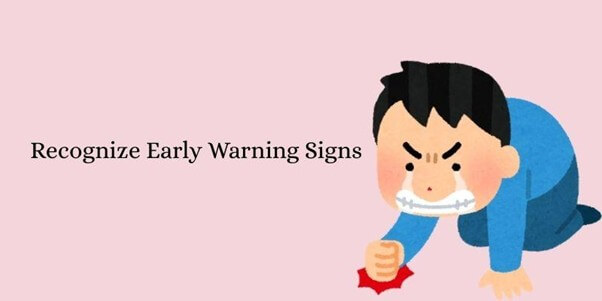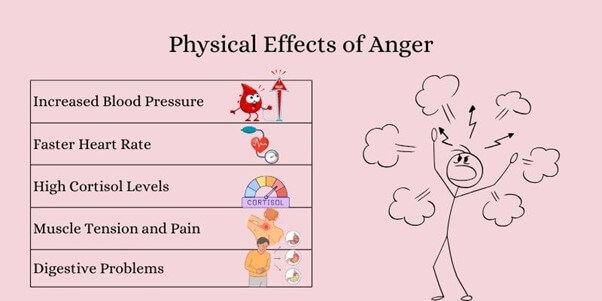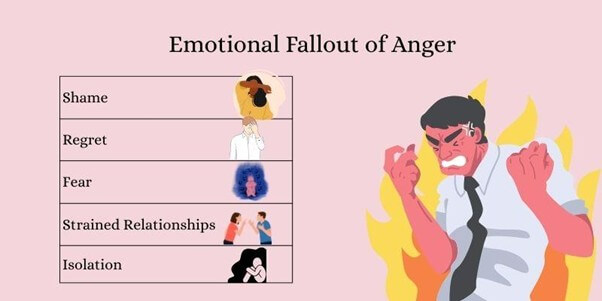10 Therapist-Approved Anger Management Tips That Actually Work (2025 Edition)
Anger is a natural emotion—we all feel it from time to time. But when anger becomes hard to control, it can hurt your relationship, health, career, and self-esteem. That’s where anger management tips come in.
Learning how to handle anger the right way doesn’t mean you ignore your feelings. It means finding healthy ways to express and release them before they cause damage.
Unmanaged anger can lead to anxiety, high blood pressure, ruined relationships, and even job loss.
It can make you say or do things you regret, and over time, it can create a cycle of guilt and stress. The good news? You can take control of your anger with the right tools.
This guide shares 10 therapist-approved anger management tips that actually work, including strategies for calming down in the heat of the moment and long-term anger control techniques.
Whether you’re someone who loses your temper quickly or you tend to bottle things up until you explode, these tips are practical, easy to apply, and based on years of professional experience.
Let’s explore how to stop letting anger take over and start responding in a way that protects your peace, your health, and your relationships.
Top 10 Anger Management Tips (Backed by Therapists)

When anger builds up, it can feel like you’re about to explode. But therapists agree that learning to manage your anger before it reaches that point is key.
The following tips are not just generic advice; they’re therapist-recommended anger management techniques you can start using today.
Whether you want to know how to control anger at work, at home, or in everyday situations, these strategies will help you stay calm, think clearly, and respond better.
1. Recognize Early Warning Signs

Tight jaw, racing heart, clenching fists — know your triggers
Before anger turns into yelling, shutting down, or doing something you’ll regret, it starts small, physically and mentally.
You might not even notice it at first. But if you pay attention, your body and thoughts send signals: maybe your fists clench, your jaw tightens, or your heart speeds up. You may feel hot, tense, or irritated. These are your early warning signs.
How to Recognize Your Early Signs
Common Physical Signs
- Jaw clenching or teeth grinding
- Tightness in the chest or shoulders
- Pounding heart or racing pulse
- Feeling hot or flushed
- Shaking or trembling
- Clenched fists
Emotional and Mental Clues
- Feeling irritated or easily frustrated
- Thoughts like “This isn’t fair” or “They always do this”
- Urge to yell, slam something, or shut down
Steps to Tune into Your Triggers
- Keep a journal: After moments of anger, write what you felt in your body.
- Rate your anger (1–10): Regularly assess how angry you’re feeling. You can also check out the anger assessment offered by Mastering Conflict!
- Track your triggers: What situations or people set you off?
The more you recognize your signs, the more control you gain. This self-awareness is the foundation for every other anger control technique.
2. Pause and Breathe Deeply
Box breathing, 4-7-8 method; include a visual or bullet walkthrough
When anger hits, your body shifts into fight-or-flight mode. Your breathing gets shallow, your heart races, and your mind speeds up.
Taking deep, slow breaths helps tell your body that you’re safe. It’s one of the fastest ways to calm down physically and mentally.
How to Practice Deep Breathing
Try Box Breathing (4-4-4-4)
- Inhale through your nose for 4 seconds
- Hold your breath for 4 seconds
- Exhale slowly through your mouth for 4 seconds
- Hold again for 4 seconds
- Repeat for 3–4 rounds
This breathing pattern creates a “box” in your mind and helps center your focus.
Try the 4-7-8 Breathing Technique
- Inhale quietly through your nose for 4 seconds
- Hold your breath for 7 seconds
- Exhale forcefully through your mouth for 8 seconds
- Do this for 4 breaths, then gradually increase over time
Tips to Make It Work Better
- Place one hand on your chest and one on your belly—feel the breath.
- Sit or stand tall to allow better airflow.
- Practice daily when you’re calm so it becomes natural when you’re angry.
Deep breathing won’t fix the situation, but it will help you handle it with a clear, calm mind. It puts space between you and your reaction, and sometimes, that space is all you need.
3. Take a Timeout (Adults Need It Too)

Physically leave the situation and reset!
Timeouts aren’t just for kids—they’re a powerful tool for adults too. When emotions are high, staying in the heat of the moment can make things worse.
Taking a timeout gives you a chance to cool down, collect your thoughts, and come back to the situation with a clearer head.
How to Take an Effective Timeout
When to Use a Timeout
- You’re raising your voice or feel like yelling
- Your thoughts feel foggy or out of control
- You’re tempted to say or do something hurtful
What to Do During the Break
- Go to another room, outside, or even to your car
- Focus on deep breathing or listen to calming music
- Avoid replaying the argument in your head — the goal is to reset
Set Expectations
- Say something like, “I need a break. Let’s talk about this in 15 minutes.”
- Make it clear that you’re not walking away for good, just taking space
Timeouts create space for reflection and help stop anger from escalating into damage.
4. Reframe the Situation
Introduce cognitive restructuring in simple terms
How we think about a situation often fuels our anger more than the situation itself. Cognitive restructuring is a fancy term therapists use to describe changing the way you think.
Instead of assuming the worst or personalizing everything, you learn to look at the situation from a new angle.
How to Reframe Your Thinking
Common Unhelpful Thoughts
- “They always disrespect me.”
- “This is the worst thing that could happen.”
- “They did this on purpose to upset me.”
How to Challenge and Reframe Them
- Ask: Is there another way to see this?
- Replace “always” and “never” with facts
- Assume positive intent (e.g., “Maybe they’re just having a bad day.”)
Use More Balanced Thoughts
- “I feel upset, but I can handle this.”
- “This is frustrating, not the end of the world.”
- “I’ll respond after I calm down.”
Reframing gives you power over your story—and when your thoughts change, your anger often fades.
5. Use “I” Statements
Example: “I feel frustrated when…” instead of blame
When you’re angry, it’s easy to start blaming: “You never listen!” or “You make me so mad!” But blaming language often makes the other person defensive and escalates the conflict. “I” statements are a simple tool to express your feelings without starting a fight.
How to Use “I” Statements
The Simple Formula
- I feel [emotion]
- When [situation or behavior]
- Because [reason]
Examples
- “I feel hurt when I’m interrupted, because I want to finish my thoughts.”
- “I feel overwhelmed when there’s clutter, because I need space to think.”
What to Avoid
- Don’t say “I feel like you’re being rude” (that’s still blame)
- Don’t use sarcasm or raise your voice—it defeats the purpose
- This technique keeps conversations respectful and reduces the chance of angry outbursts.
6. Get Physical

Walk, exercise, clean — get that energy out constructively
Anger is energy, and it needs somewhere to go. When you keep it bottled up, it builds and eventually explodes.
One of the healthiest ways to release that energy is through movement. Physical activity distracts your mind, burns off tension, and releases feel-good chemicals like endorphins.
How to Use Physical Activity to Cool Down
Quick Physical Releases
- Go for a brisk walk (even 10 minutes helps)
- Do jumping jacks or stretch in place
- Clean or organize a room
- Punch a pillow or scream into one (safely and privately)
Long-Term Physical Activities
- Join a fitness class or boxing gym
- Practice yoga or tai chi for mind-body control
- Use physical hobbies like biking, hiking, or swimming
Keep It Accessible
- Have a list of go-to physical activities for when anger builds
- Don’t wait until you’re boiling—use movement at the first signs
Physical activity channels your anger into something healthy. It clears your head, calms your body, and helps you return to the situation with a more balanced mindset.
7. Write It Out
Journaling or a note to self (you don’t have to send it)
Sometimes, what you really need is to just get it out. Writing helps you process feelings that are too intense or jumbled to say out loud.
Whether it’s a journal entry or an unsent letter, putting your thoughts on paper can reduce anger and give you a fresh perspective.
How to Use Writing as a Tool
Journaling Prompts for Anger
- What triggered me today, and why?
- What was I really feeling underneath the anger?
- What do I need or want that I’m not getting?
- What would I say if I didn’t fear the consequences?
Writing a “No-Send” Letter
- Write a letter to the person you’re angry at
- Say everything you feel—but don’t send it
Use this to release anger and understand your emotions better
Make It a Daily Practice
- Set aside 5–10 minutes to write before bed
- Don’t worry about grammar—just be honest
- Use a notebook, notes app, or even a voice memo
Writing creates emotional distance. It turns anger into insight, and insight is the first step to change.
8. Practice Mindfulness or Grounding
Mindfulness-based stress reduction (MBSR); quick grounding techniques
Mindfulness is about staying present—tuning into what’s happening right now, without judgment.
Grounding techniques help you stay connected to the current moment instead of getting lost in overwhelming anger. Together, they train your brain to pause and reset.
How to Practice Mindfulness and Grounding
Simple Grounding Techniques
- 5-4-3-2-1 Method: 5 things you see, 4 things you can touch, 3 things you hear, 2 things you smell, 1 thing you taste
- Cold water splash: Splash your face or hold an ice cube to reset your nervous system
- Feel your feet: Press them into the floor, notice the pressure
Basic Mindfulness Practices
- Sit quietly and focus on your breath
- Notice your thoughts without reacting to them
- Use an app like Headspace or Calm
Just a few minutes a day can rewire how your brain handles stress and anger.
9. Laugh It Off or Use Humor
Use caution — not sarcasm or mockery, but light-heartedness
Humour has a surprising superpower—it can diffuse tension, break mental patterns, and help you take yourself less seriously.
But it must be used wisely. The goal isn’t to make fun of others or avoid the issue; it’s to soften the edges of anger with a little levity.
How to Use Healthy Humor to Cope
What Works
- Watch a funny video or comedy show
- Make light of your own overreaction: “Okay, I’m acting like someone just stole my lunch money.”
- Use inside jokes with trusted people to ease tension
What to Avoid
- Don’t use sarcasm to mock someone (it will escalate things)
- Don’t use humour to ignore serious issues—deal with them once calm
- Don’t force it—use humour when it feels natural
Humour doesn’t erase the anger problem, but it can help you approach it with less heat and more perspective.
10. Talk to a Professional
Sometimes, anger runs deeper than just bad days or irritating moments. If your anger feels too intense, too frequent, or starts to hurt your relationships, it might be time to talk to a professional.
Therapy gives you a safe space to understand your triggers and build long-term anger control strategies.
How to Get Started
Signs You Might Benefit from Therapy
- You often regret what you say or do when angry
- You feel stuck in anger or resentment
- Your anger is affecting your work, relationships, or health
- You’ve tried tips but still feel out of control
What a Therapist Can Help With
- Identifying your core triggers
- Teaching calming techniques and emotional regulation
- Helping you reframe thoughts and build better communication habits
- Offering support, not shame
If you’re ready to take that next step, book a confidential consultation with one of our anger specialists at Mastering Conflict. Help is available, and change is absolutely possible.
Why Managing Anger Matters
Anger is a normal emotion, but when it’s unmanaged, it can quietly harm almost every part of your life.
Many people don’t realize the long-term impact until it shows up as health issues, isolation, or emotional burnout. That’s why learning to manage anger isn’t just about staying calm—it’s about protecting your overall well-being.
The effects of unresolved or frequent anger go much deeper than raised voices or slammed doors. Let’s break down how unmanaged anger impacts your body, your emotions, and your mind.
Physical Effects (Blood Pressure, Heart Rate, Cortisol)

When you’re angry, your body goes into “fight or flight” mode. If this happens often, it can take a serious toll on your physical health.
- Increased Blood Pressure: Frequent anger keeps your blood pressure elevated, which increases the risk of heart disease, stroke, and long-term cardiovascular damage.
- Faster Heart Rate: Anger causes your heart to beat faster and harder, which can make you feel dizzy or out of breath, and over time, may strain your heart.
- High Cortisol Levels: Cortisol, the body’s stress hormone, rises during anger. Chronic exposure can weaken your immune system, increase belly fat, and affect memory and sleep.
- Muscle Tension and Pain: Anger makes your muscles tighten, especially in the shoulders, neck, and back, leading to chronic pain or tension headaches.
- Digestive Problems: Ongoing stress and anger can slow digestion or cause symptoms like stomachaches, acid reflux, or nausea.
Emotional Fallout (Shame, Regret, Fear, Relationship Strain)

Anger doesn’t just affect your body—it also leaves emotional marks, especially after an outburst or conflict.
- Shame: You may feel embarrassed about what you said or did in the heat of the moment, especially if it hurt someone you care about.
- Regret: Anger-driven decisions often lead to guilt—wishing you could take words or actions back.
- Fear: Others may start to walk on eggshells around you, or you may fear your own reactions if you feel out of control.
- Strained Relationships: Constant anger erodes trust and communication, making friends, partners, and coworkers feel unsafe or distant.
- Isolation: If people pull away, it can lead to loneliness and a sense of being misunderstood or rejected.
Link Anger to Mental Health (Anxiety, Burnout, Depression)
Anger doesn’t just exist on its own—it often overlaps with or fuels other mental health challenges.
- Anxiety: When you constantly worry about losing control or dealing with conflict, it can create or worsen anxiety symptoms.
- Burnout: Repressed anger or frequent outbursts can drain your emotional energy, making it hard to focus, feel motivated, or enjoy life.
- Depression: People who internalize anger may feel hopeless, emotionally numb, or stuck in a cycle of self-blame and sadness.
- Low Self-Esteem: If anger makes you act in ways you regret, you may start to believe you’re a “bad person,” which chips away at your confidence.
- Irritability and Mood Swings: These are common in people dealing with untreated anger, especially when it’s tied to unresolved trauma or stress.
Managing anger is more than just calming down—it’s a form of self-care that protects your body, your peace of mind, and your most important relationships.
When These Tips Aren’t Enough: Signs You May Need Help
While self-help strategies can go a long way in managing day-to-day frustration, there are times when anger becomes overwhelming or dangerous.
If you’ve tried calming techniques, reframing, or breathing exercises—and your anger still feels out of control—it may be time to seek professional support.
Anger is a serious issue when it affects your safety, your family, your career, or even your legal standing.
Here are some warning signs that your anger may require more structured help, like therapy or a court-approved anger management program.
Escalating Anger
- Your anger is becoming more intense or frequent over time
- Small triggers now cause big reactions
- You feel like you’re “always on edge” or ready to snap
- You often go from calm to enraged in seconds
When anger escalates like this, it can signal deeper emotional issues—like trauma, stress, or unresolved hurt—that require guided therapy.
Impact on Family or Job
- Loved ones are afraid of how you’ll react
- Arguments at home are more frequent and intense
- Coworkers avoid you, or you’ve had disciplinary issues at work
- You feel isolated because people are pulling away
Uncontrolled anger can erode trust, create fear, and lead to lasting damage in your most important relationships—both personal and professional.
Legal Consequences
- You’ve had run-ins with the law due to your temper
- There’s a history of domestic disputes, road rage, or physical altercations
- A judge or employer has suggested anger management
These situations are serious. Legal issues tied to anger can affect your future, freedom, and record.
Consider Court-Ordered Anger Management Classes
If you’ve been ordered by the court to take an anger management course or think you may need one, MasteringConflict offers therapist-designed, evidence-based online anger management classes that meet court and employer requirements.
They’re confidential, easy to access, and focused on helping you regain control before anger causes irreversible harm.
If your anger is hurting you or others, it’s not too late to seek help. Reaching out is a sign of strength, not failure.
FAQs About Anger Management Tips
Can anger be controlled without therapy?
Yes, many people learn to manage anger using self-help strategies like breathing exercises, journaling, and mindfulness. However, if anger is intense or persistent, therapy can offer deeper, lasting support.
Is it OK to feel angry sometimes?
Absolutely! Anger is a natural human emotion. It becomes a problem only when it’s frequent, overwhelming, or leads to harmful behaviour.
How long does it take to see improvement?
With consistent effort, many people notice changes in a few weeks. Lasting improvement depends on your triggers, mindset, and how regularly you use anger control techniques.
Conclusion
Managing anger isn’t about never getting upset—it’s about learning how to respond in a healthier, more constructive way.
Whether you’re dealing with stress at work, tension at home, or just trying to stop losing your temper over small things, these therapist-approved anger management tips can make a real difference.
By recognizing your warning signs, practicing calming techniques, and expressing yourself clearly, you take control instead of letting anger control you.
If you’ve been wondering how to control anger and feel like you’re stuck in old habits, remember: change doesn’t happen overnight, but small steps lead to big results.
Everyone’s journey with anger is different, and there’s no shame in seeking extra support if you need it.
At MasteringConflict.com, we believe emotional awareness is the key to stronger relationships, better health, and lasting peace of mind.
Start with the tips in this guide—and when you’re ready, take the next step toward mastering your emotions, not just managing them.


13 Responses